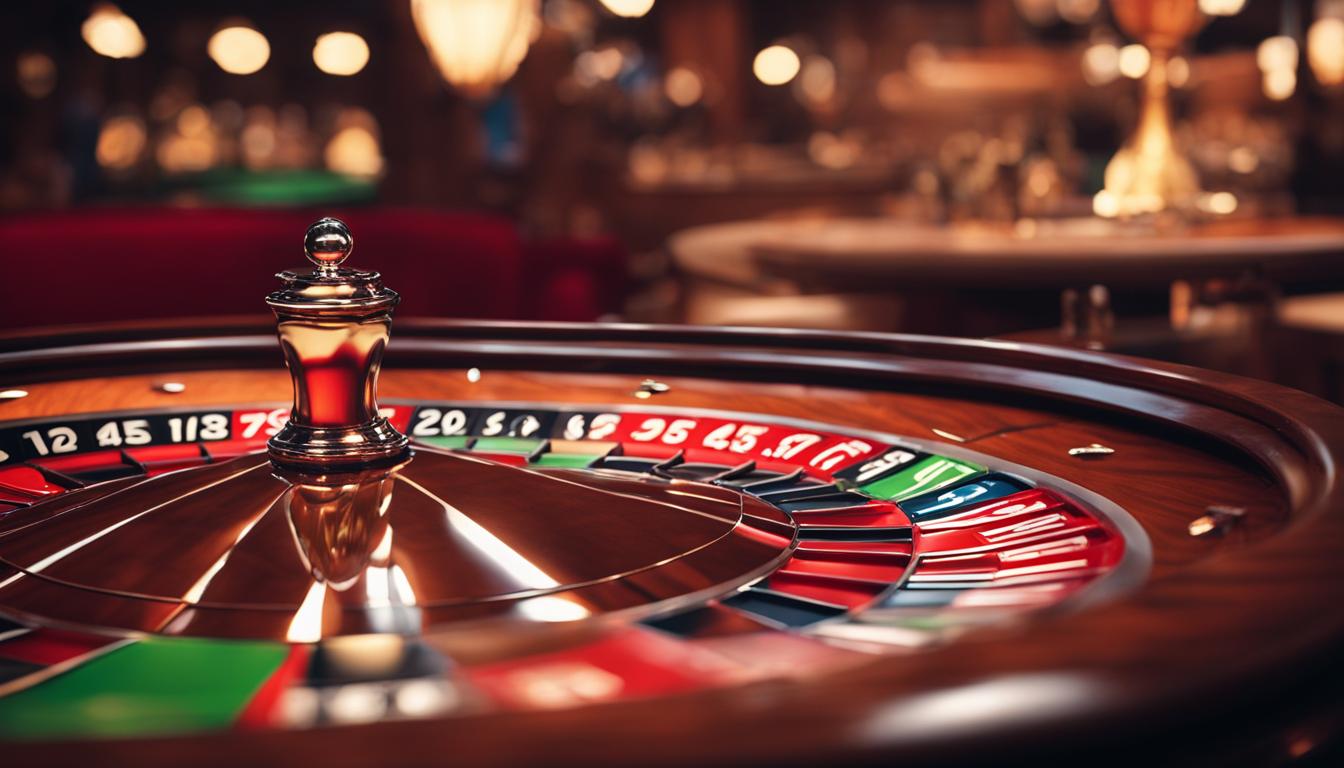Roulette wheels are recognizable in almost every casino, capturing the attention of thrill-seekers and gambling enthusiasts alike. But what do roulette wheels do essentially and why are they such an important element of casino gaming? In this section, we’ll explore the purpose of roulette wheels and shed light on their fundamental functions.
How Do Roulette Wheels Work?
Roulette wheels are fascinating gaming devices that rely on intricate mechanisms to produce random outcomes. To understand how these wheels work, let’s take a closer look at their inner workings.
The layout of a roulette wheel features numbered slots, each alternating in color between red and black, with one or two green slots for the 0 and 00 in American roulette. The ball rests on the wheel’s spinning mechanism as it rotates in the opposite direction to the wheel’s spin. Eventually, the ball loses momentum and comes to rest in one of the numbered slots on the wheel.
The spinning mechanism of a roulette wheel is a carefully balanced spindle with a brass ball bearing offering consistent and near-frictionless rotation. The wheel’s frets are the raised bumps situated between numbered slots that slow down the ball’s progress as it approaches the end of the spin. Additionally, they contribute to the randomization of the ball’s trajectory as it skips between the frets, making it challenging to predict where the ball will land.
Understanding the inner workings of roulette wheels is crucial as it gives insight into the fairness and randomness of roulette gameplay. It is the intricate combination of the layout, the spinning mechanism, and the ball trajectory that produces the randomized results players rely on during a game of roulette.
Components of a Roulette Wheel
A roulette wheel may seem like a simple device, but it is a complex and precisely designed instrument with various intricate components that contribute to its overall function. Here are the four main parts that make up a roulette wheel:
| Component | Description |
|---|---|
| Wheel Head | The top of the wheel that contains the numbered pockets where the ball lands to determine the winning number. |
| Bowl | The bowl-shaped base of the wheel that houses the wheel head and supports the spinning mechanism. |
| Spindle | The central axis that connects the wheel head and bowl, allowing the wheel to spin freely and smoothly. |
| Frets | The metal dividers that separate the numbered pockets, ensuring that the ball bounces and settles randomly before coming to a stop. |
Each of these components plays an essential role in the functioning of the roulette wheel. The wheel head and bowl comprise the majority of the structure, while the spindle and frets facilitate the spinning and distribution of the ball. Without any of these components, the roulette wheel would not be able to produce the random and exciting outcomes that it is known for.
Understanding these components will deepen your appreciation not only for the engineering behind roulette wheels but also for the craftsmanship that goes into building them.
The Purpose of Roulette Wheels
When it comes to casino gaming, roulette wheels serve a fundamental purpose of generating winning outcomes for players. In essence, the roulette wheel acts as the primary instrument for determining which numbers and bets win, creating a thrilling and suspenseful atmosphere for players.
By providing a randomized outcome, roulette wheels ensure a fair and impartial game for all players, creating an exciting and unpredictable gameplay experience that keeps players coming back for more.
“Roulette is the perfect combination of luck and strategy, with the roulette wheel acting as the centerpiece of this dynamic and engaging game.”
As one of the most iconic features of casino gaming, roulette wheels play a significant role in setting the overall tone and atmosphere of the gaming floor. Their presence lends a sense of sophistication and excitement to any casino environment, enticing players to try their luck and challenge the odds.

The Role of Roulette Wheels in Casino Gaming
While roulette wheels are the centerpiece of the game of roulette, they also have a broader significance for the world of casino gaming. The inner workings of roulette wheels enable players to experience casino games like never before, creating an atmosphere of excitement, anticipation, and possibility. Roulette wheels are an essential part of the gaming experience, contributing to the entertainment value and strategy of the game.

What roulette wheels do essentially is act as the primary mechanism for determining the winning outcomes that keep players on the edge of their seats. The intricate components that make up the roulette wheel contribute to the complexity and the allure of the game.
| Component | Description |
|---|---|
| Wheel head | The top of the roulette wheel that holds the bowl and displays the winning numbers. |
| Bowl | The stationary part of the roulette wheel where the ball comes to rest. |
| Spindle | The central shaft that connects the wheel head to the bowl and spins the wheel. |
| Frets | The partitions separating the numbered pockets on the wheel. |
Understanding the significance of roulette wheels in the larger context of casino gaming underscores the vital role they play in the artistry and dynamics of the industry. By grasping the inner workings of these enigmatic devices, players can unlock a deeper appreciation for the ingenuity and craftsmanship that goes into creating some of the world’s most beloved casino games.
Factors Influencing the Outcome on Roulette Wheels
While roulette wheels are designed to provide a fair and random gameplay experience, various factors can influence the outcome. The inner workings of roulette wheels can affect the distribution of winning numbers, and imperfections in the wheel itself can introduce biases and patterns that increase the chances of certain outcomes.
Bias in roulette wheels
Wheel bias can result from imperfections in the manufacturing process, wear and tear, and even temperature changes. Some wheels may have a certain pocket that’s slightly bigger or more raised than the others, or a fret that’s looser or tighter than the others. Over time, as the wheel spins repeatedly, these imperfections can influence where the ball lands. Statistically, some numbers may come up more often than others, leading to biased outcomes.
The role of the croupier
In addition to wheel bias, the actions of the croupier can also impact the outcome of the game. The speed and force with which the croupier spins the wheel, as well as the speed at which the ball is launched, can all influence where the ball ends up. Croupiers may also have their own individual styles and tendencies, which can introduce patterns and biases into the game.
“It’s worth noting that significant biases in modern roulette wheels are considered relatively rare.” – John Marchington, CEO of a casino game development company.
To minimize the impact of these factors on the gameplay experience, casinos regularly monitor and maintain their roulette wheels. They may also switch out wheels periodically to ensure that no significant biases develop over time. Players should also be aware of the potential for biased outcomes and make informed decisions when placing their bets.
A good website with promotions must be 89ufabet.
Conclusion
In conclusion, understanding the purpose and inner workings of roulette wheels is essential for gaining a comprehensive understanding of the game of roulette. From the components that make up the wheel to the factors that can influence the outcome, roulette wheels play a vital role in casino gaming.
By grasping the dynamics of roulette wheels, players can develop a strategy and approach that can enhance their chances of winning and improve their overall gaming experience. Furthermore, appreciating the artistry and craftsmanship behind these iconic casino devices can also add to the excitement and entertainment value of the game.
So, next time you step into a casino and hear the sound of the roulette ball clattering around the wheel, take a moment to appreciate the intricate mechanics and fascinating history of this classic casino game.
FAQ
What do roulette wheels essentially do?
Roulette wheels are the main instrument used in the game of roulette. They determine the winning outcomes by spinning and randomly landing on a specific number and color. Essentially, roulette wheels create a thrilling and suspenseful atmosphere in the casino gaming experience.
How do roulette wheels work?
Roulette wheels work through a combination of mechanics and physics. The wheel consists of numbered pockets, colored in red and black, with a small ball spun in the opposite direction. As the wheel slows down, the ball eventually falls into a pocket, indicating the winning number and color. This process ensures fairness and randomness in the game.
What are the components of a roulette wheel?
A roulette wheel consists of several components. The wheel head is the upper part where the numbered pockets are located, while the bowl is the lower part that houses the wheel head. The spindle connects the wheel head to the bowl and allows for smooth spinning, while the frets divide the numbered pockets and provide additional randomness.
What is the purpose of roulette wheels?
The primary purpose of roulette wheels is to determine the winning outcomes in the game of roulette. They create excitement and anticipation for players as they wait for the ball to land on a specific number and color. Roulette wheels play a crucial role in creating a thrilling and immersive casino gaming experience.
What role do roulette wheels play in casino gaming?
Roulette wheels are a central element of casino gaming, particularly in the game of roulette. They contribute to the overall strategy, excitement, and entertainment value of the game. Roulette wheels are iconic symbols of the casino, attracting players with their aesthetic appeal and promising the chance of big wins.
What factors can influence the outcome on roulette wheels?
Several factors can influence the outcome on roulette wheels. Wheel imperfections, such as bias and wear, can cause certain numbers or colors to be more likely to win. Additionally, the actions of the croupier who spins the wheel and launches the ball can influence where the ball lands. These factors add an element of uncertainty and strategy to the game.













